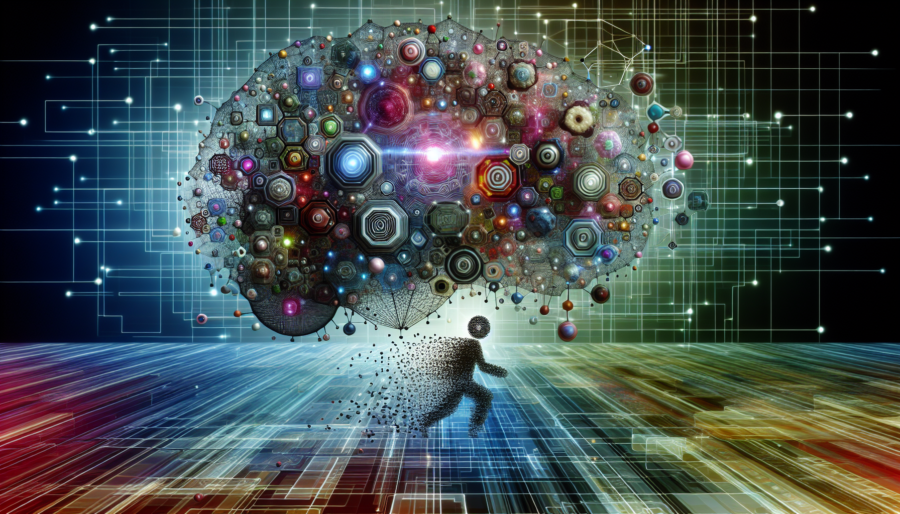The collective thought of the digital swarm is a phenomenon that develops thanks to the spread of digital technologies and their ability to connect people globally.
This phenomenon is often associated with the notion of “collective intelligence” and is characterized by the ability to create new forms of social bonding, no longer based on territorial belonging or power relations, but on gathering around common centers of interest, play, sharing of knowledge and cooperative learning.
This type of collective intelligence develops through the active participation of people, who share experiences, opinions and knowledge in real time, creating an environment of collaboration and continuous learning.
In this context, collective intelligence presents itself as a form of emancipation and civilization, as it allows each person to express themselves freely and to appeal to the intellectual resources and human qualities of the community.
The concept of “hive mind” is closely related to this phenomenon, as it describes the ability of people to work together, share information and thoughts, and create a collective opinion that can be broader and more complex than the individual one.
This type of collective thinking can be influenced by digital narcissism, which can lead to greater self-awareness and opinions, but also to greater distraction and superficiality in communication.
In this context, the laws of onlife life are changing the way digital communities think and act. The term derives from the contraction of Online and Offline, so from the union between the actions of our life when we are connected to the network and when we are disconnected. “
I coined this neologism a few years ago to highlight the hybrid nature of our daily experiences, partly digital and partly analog,”
Luciano FLORIDI
The spread of digital technologies has led to greater global connection, but also to greater fragmentation and distraction.
It is therefore important to understand how these technologies are influencing our relationships and our perception of the world, in order to create a more sustainable and aware future.
Digital narcissism is a phenomenon that has developed with the advent of digital technologies and social media. It is characterized by extreme egocentrism, self-aggrandizement and a constant need for approval and attention from others.
This type of narcissism manifests itself through the publication of personal content, such as selfies and stories, which are intended to obtain “Likes” and comments.
Since the second half of the last century, our daily life has become an increasingly interconnected field, the so-called “fourth revolution” of Luciano Floridi in the essay The Fourth Revolution.
How the infosphere is transforming the world. Connections to computer networks make every person reachable by information from any part of the world. We are not only receivers of information, but “interconnected informational agents”.
The term “infosphere” was coined in the 1980s by Alvin Toffler, who defined it as the “third wave” of communication that is radically changing society and culture.
In the 2000s, Floridi took up and further developed this concept, emphasizing how the infosphere is profoundly transforming the human being, leading us to live in an “onlife” dimension in which online and offline are now indistinguishable. In the infosphere, we are prosumers, that is, producers and consumers of ideas and information, often relaunching them in an endless cycle on the web.
The network has created new accesses and has expanded enormously, governed by fluidity. In the software society, as theorized by Derrick de Kerckhove in 2010, everything becomes malleable and interchangeable, shaping both the material elements and the immaterial structures of our culture.
This concept is closely related to the theory of the software of the mind, developed by Geert Hofstede and Michael Minkov, which argues that the values and beliefs that guide our actions are expressed and communicated through a set of cultural rules and norms that can be modified and adapted according to circumstances.
In this context, the malleability and interchangeability of cultural structures are essential to understand how people interact and adapt to new situations. The theory of the software of the mind suggests that values and beliefs are central to leadership and intercultural communication, and that the ability to adapt to new situations is essential for success in culturally diverse contexts.
The notion of the malleability and interchangeability of cultural structures is also closely related to the theory of cultural mindset, which argues that people can have a fixed or malleable mindset in relation to their cultural beliefs and attitudes.
A malleable mindset is more likely to consider the possibility of cultural changes and to be open to adaptation and learning, while a fixed mindset tends to consider cultural beliefs as fixed and immutable.
In the digital society, where we not only use technology but become technology, we are isolated individuals in interconnection.
The digital is not neutral, shaping our thinking and behavior. On the network, we are not only passive users, but active agents in a constant communicative flow.
The digital community is a sort of “hive mind” with a collective consciousness.
According to what is described in the essay “In the Swarm. Visions of the Digital” by Byung-Chul Han, the “digital swarm” that characterizes contemporary society is composed of isolated individuals, devoid of a unifying soul or spirit as happened instead in the traditional crowd.
Although connected and able to communicate quickly, individuals in the digital swarm do not develop a true “We” and lack internal coherence.
Even when phenomena of collective indignation occur online, such as “shitstorms”, this cohesion is only apparent and superficial, lacking a true unifying voice.
So, unlike the crowd of the past, the digital swarm is characterized by a weak and fragmented connection between individuals, who maintain their private identity even when acting as a group.
The digital revolution has thus eroded the sense of collectivity, making individuals more isolated and focused on optimizing their personal image and identity.
Contemporary society is often characterized by a climate of indignation and derision, in which respect and constructive dialogue seem to be lacking.
This phenomenon can be exacerbated by the media and social networks, which offer a space to vent resentment in a controlled and institutionalized way.
However, derision and indignation do not always lead to the expulsion of the target from the community.
Sometimes they are channeled into socially acceptable forms, such as comedy, which ritualizes the comic experience within defined boundaries.
Furthermore, the media can act in a containment way with respect to the destructive power of laughter, while offering a space for its expression.
Gramsci emphasized the importance of civil society in the formation of ideology, which is not artificially imposed but emerges from the connection of different elements present in social reality.
(Antonio Gramsci (1891-1937) was an Italian Marxist philosopher, journalist, and politician)
In this sense, the lack of dialogue and stability in the public sphere can be seen as a reflection of deeper trends in society.
Digital narcissism and the extreme personalization of the Self undermine representative democracy, transforming our subjectivity into a self-performing project.
Digital narcissism and the extreme personalization of the Self can undermine representative democracy through fragmentation and atomization, manipulation and control, polarization and radicalization, and the loss of empathy and humanity.
Vilém Flusser described digital connection as an opportunity to reduce subjectivity, but the reality of the network can lead to “ego islands”. From afar, digital connection seems a paradise of souls, but up close, it can turn out to be a series of isolated ego points.
This contradiction has been analyzed by Flusser, who noted how the human condition in the world dominated by technological apparatuses can appear bottomless, with a deep void opening up in depth.
This void can be filled by human relationships, which Flusser describes as a “field of intersubjective relations” where the individual finds himself immersed in a network of relationships that connect him with others.
How to Save Yourself?
Disconnection and re-connection: It is important to disconnect from digital technologies and reconnect with the real world to maintain a balanced mental health.
Authenticity: The search for authenticity and genuineness is a good antidote to digital narcissism.
Moderation: Using social media in moderation and not excessively can help reduce the risk of developing digital narcissism.
One might wonder what is the role of bloggers in the world described by Byung-Chul Han. Every critical theory, including that of Byung-Chul Han, has an origin and a point of view, represents an interpretation of reality, but it is not clear what Han’s is.
The risk of these radical criticisms (one is reminded of the “critical criticism” with which Marx mocked Bruno Bauer in “The Holy Family”) and of these great epochal syntheses, is to make an indirect defense of what is criticized: even reading this article and sharing it would only add data to big data and perpetuate your own subordination.
Let’s ask ourselves if the opposition movements that periodically emerge on the world scene and often use the network are not a counterexample to the current form of totalitarianism described by the author.
Let’s also ask ourselves if the utopia of big data to map the world really allows their use and if the possibility of predict

